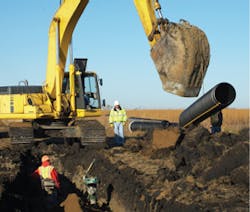Project Profile: Minnesota Hunting Lake Undergoes Habitat Restoration
Ask the locals, and they’ll be quick to tell you that Olson Lake in rural Minnesota was once a shallow and flourishing duck habitat. Shots rang out every fall as hunters bagged their limits of mallards, wood ducks, and Canada geese. But, in time, prolonged high water levels–combined with runoff from agricultural fields, and the introduction of invasive fish species–left the water in a turbid state, resulting in a deep and mucky slough. Over the years, the waterfowl and other wetland-dependent wildlife disappeared, leaving hunters to wonder what had ever happened to all the ducks.
Now, in an effort to restore Olson Lake to its former glory as a staging, breeding, and feeding ground for migrating waterfowl, engineers and biologists from Ducks Unlimited and the US Fish and Wildlife Service have teamed with Prinsco Inc. to re-habitat the wetland and improve water quality.
Olson Lake is a small, 140-acre lake, located just east of the small town of Raymond in west central Minnesota. It is included in Minnesota’s list of “public waters,” and much of the shoreline is surrounded by the native grass uplands of the US Fish and Wildlife Service’s 440-acre Olson Lake Waterfowl Production Area.
According to Jim Streifel, project engineer for Ducks Unlimited, the lake was chosen for this re-habitat project because, historically, it was always a very good waterfowl lake. It was a shallow hemi-marsh with approximately 50% open water and 50% emergent vegetation. However, because of changes within the watershed and precipitation patterns, the water level became deeper during the 1980s, killing off underwater vegetation that is critical to a duck’s habitat.
In time, rough fish like bullhead, carp, and fathead minnows were introduced to the lake, either by migration through manmade drainage systems or by private bait dealers. Soon, these invasive species began stirring up the water and feeding on invertebrates that help control the amount of algae. The increased levels of algae blocked out sunlight and prevented underwater vegetation from growing. Without that critical vegetation, the amount of phosphorous in the water rose, leading to even higher algae blooms–a vicious cycle.
Biologists from the US Fish and Wildlife Service and Ducks Unlimited determined that the best solution to restoring Olson Lake’s water quality and waterfowl habitat was to undertake a complete drawdown of the lake.
“We’ve had tremendous success with projects like this in the past,” says Steve Erickson of the Fish and Wildlife Service. “It’s based on sound science that simulates a natural drought.”
According to Erickson, periodic droughts are healthy to a shallow lake and are necessary for restoring waterfowl habitat. The drawdown of Olson Lake will kill all invasive fish and dry out the muddy bottom. Once the substrate is exposed to oxygen, seeds of native aquatic plants that were previously “banked” in the mud will begin to germinate and grow, stabilizing the organic soils and absorbing nutrients that would otherwise fuel unwanted algae blooms.
Two construction alternatives were considered to achieve the desired drawdown effect. The first was a water control structure with an open channel outlet. However, because this model had the potential to adversely impact downstream wetlands, the team decided on a gravity-flow piped outlet instead.
For the pipeline design, various sizes and types of pipe were considered. Project engineers chose a 24-inch-diameter pipe based on the estimated length of time required to remove 3 feet of water from the lake. Prinsco’s dual-wall ECOFLO high-density polyethylene pipe was selected based on flow characteristics, ease of installation, economics, and eco-friendly recycled pipe material. “It’s an environmentally friendly product, made from 50% recycled material,” says Streifel. “So, we’re using sustainable materials to create a sustainable duck habitat. A perfect fit.”
“This is a great opportunity to work together on a project that will benefit both the wetland and its wildlife,” says Prinsco vice president Jamie Duininck. “I hope we can do more projects together in the future.”
Work began on the 3,600-foot pipeline project on October 20, 2008. A water control structure was installed on the east shoreline of Olson Lake, and the outlet pipe installation was completed on October 31. The outlet pipeline was installed over a granular base material and backfilled to the top of the pipe using a select pipe bedding material.
The inlet into Olson Lake used a 24-inch-diameter reinforced concrete pipeline, 60 feet in length, with a sloped inlet section. Dewatering of Olson Lake began on November 3, 2008, and the inlet pipeline was completed on December 11.
Extremely cold weather set in during early December, causing thick ice to form, bringing an end to the water drawdown. Investigation by the Fish and Wildlife staff determined that ice had formed all the way to the lake’s bottom, ensuring a complete winterkill of the lake’s fish.
Final and complete drawdown will occur during the spring thaw. Erickson anticipates that the lake’s exposed mudflats will be a smorgasbord for a wide variety of migratory birds during the upcoming spring migration. “We anticipate seeing multitudes of shorebirds and waterfowl using the area this spring,” he says. “Hopefully, the success of the Olson Lake project will garner the public’s interest and support for other similar opportunities in the region.”
After one or two growing seasons, the lake will be allowed to re-flood through normal precipitation and runoff. If warranted, the installed water control structure will allow management of Olson Lake’s water levels in future years.
